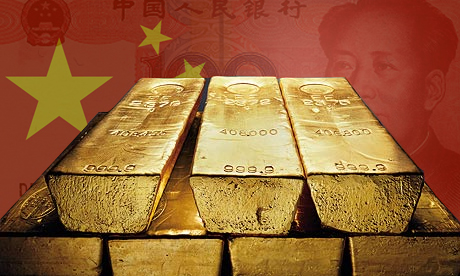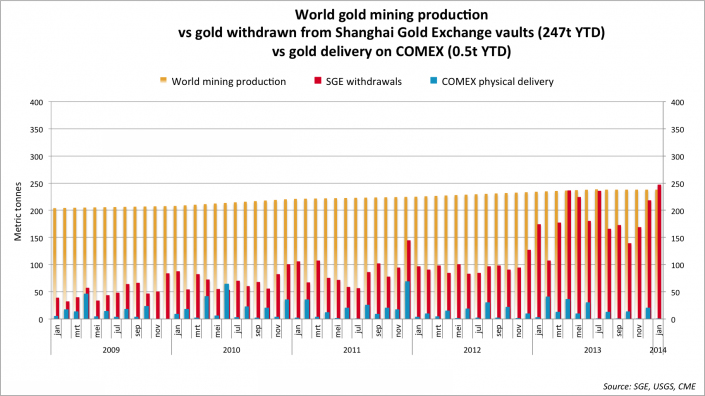 As gold has climbs above $1,300 an ounce, investors are starting to wonder if this jump might have anything to do with a tremendous increase in demand from China. According to InGoldWeTrust, withdrawals from the Shanghai Gold Exchange (SGE) vaults in January 2014 account for 247 tons, which is an increase of 43% compared to January 2013 and an all-time monthly record.
As gold has climbs above $1,300 an ounce, investors are starting to wonder if this jump might have anything to do with a tremendous increase in demand from China. According to InGoldWeTrust, withdrawals from the Shanghai Gold Exchange (SGE) vaults in January 2014 account for 247 tons, which is an increase of 43% compared to January 2013 and an all-time monthly record.
Getting a straight answer about gold demand is not an easy task these days. Fortunately, the SGE continues to publish its withdrawal numbers which some experts call the best benchmark in the gold market. In Gold We Trust posted this chart that shows the huge demand in China for gold and it also shows SGE withdrawals outpacing world gold mining production.

The fact that this demand is not believed to be reflected in current gold prices lends credence to the allegations of gold price manipulation. It also raises a couple of important questions for gold investors: when will gold prices rise due to this increased demand and why has demand jumped so drastically in China?
The first question is tough to answer. If the U.S. is in fact suppressing gold to keep the value of the dollar high, then gold prices may remain unpredictable until the scandal is given more attention. The relatively easy question to answer is why the demand is spiking so dramatically.
Chinese New Year is the easy explanation for the increased demand, as there is always a bump. But it does not explain the record number of withdrawals. Combine the Lunar New Year with one of the fastest growing middle-classes in the world, however, and the picture becomes clearer. So the mix of demand, increased household wealth, and low gold prices seems to be the formula for record withdrawals.
This leads back to the first question, will this increased demand help gold prices? Historically, the seasonal demand in China has not had much of an impact on gold prices. The difference now is that China is also the leading miner of the yellow metal and the Shanghai Gold Exchange is actively inviting foreign banks to join. This could lead China to be a price setter as opposed to a price taker.
The bottom line is that increased demand is never a bad thing for prices, especially when it is outpacing supply. Price manipulation scandals are a huge wrench in the formula, however, and make predicting price increases tricky. However, most experts agree that gold is relatively undervalued and demand around the world should continue to remain high.

